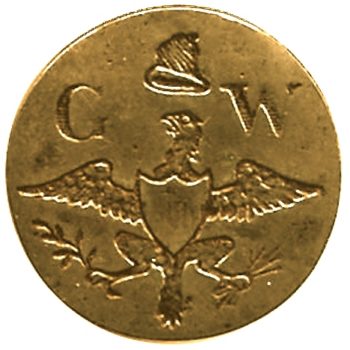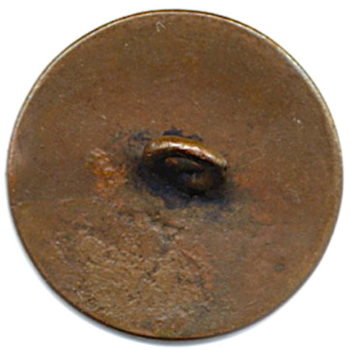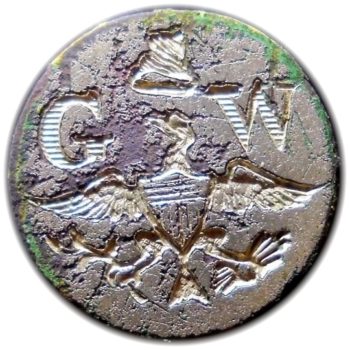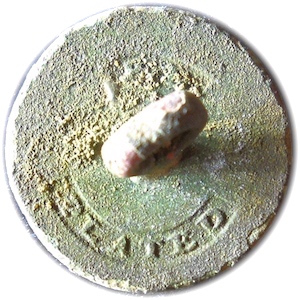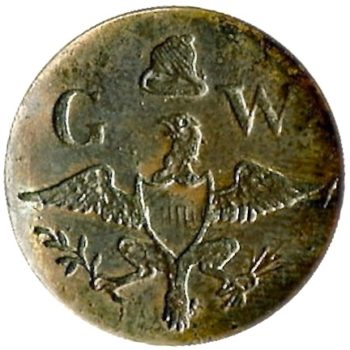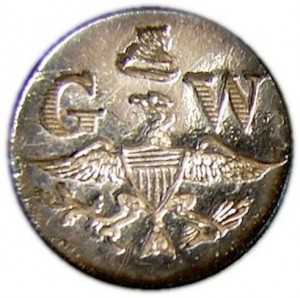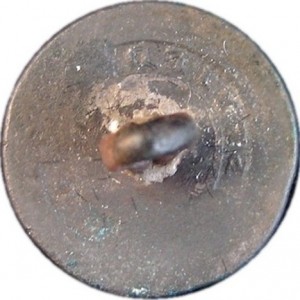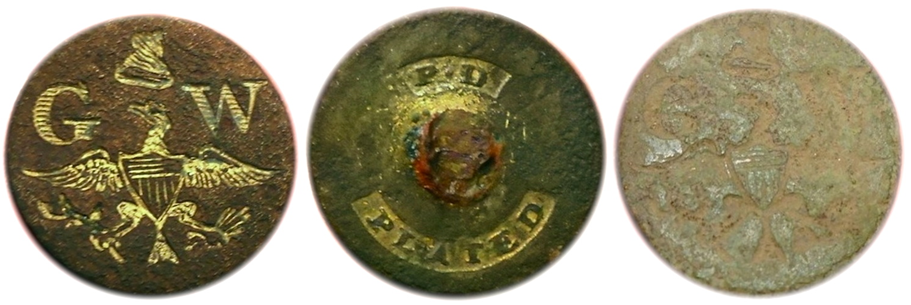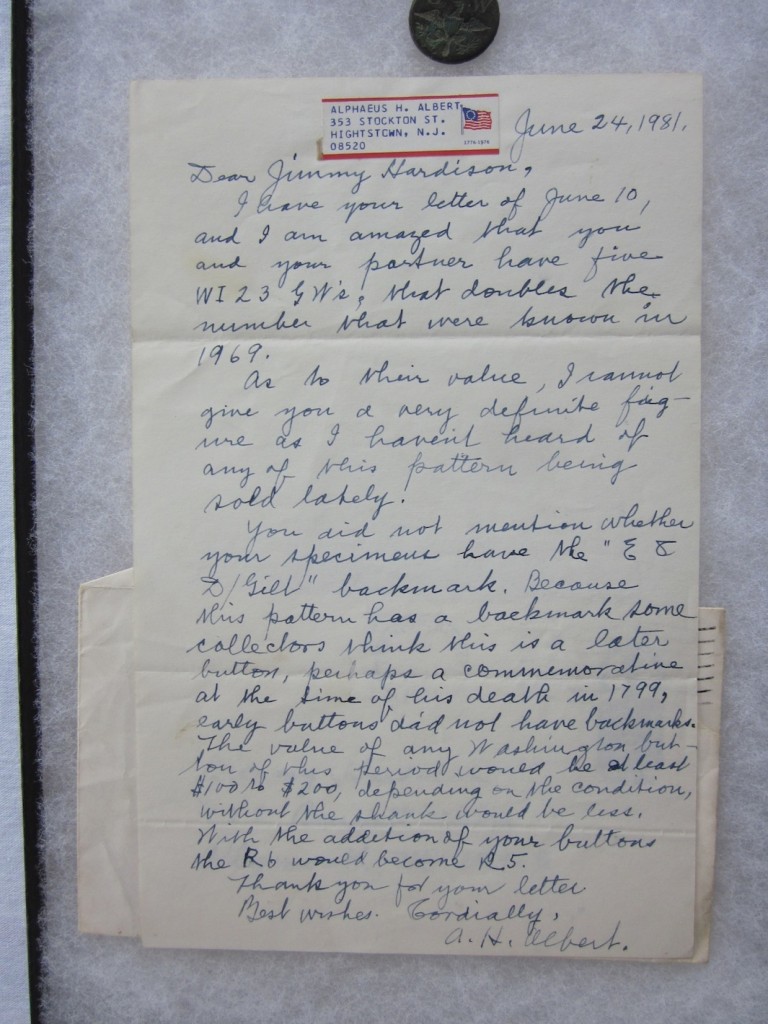1792-97 George Washington Inaugural Button, GWI 23
*
GWI 23 A & B THE “GW” MONOGRAM WITH EAGLE & LIBERTY CAP: This later date inaugural button serves as a Americas 1st successful mile marker for a self-governing Republic. Importantly, we have an elected President instead of a Parliamentary system or Monarchy rule as other European nations for centuries had. These Celebratory buttons should serve as an affirmation in the hopes, dreams, and desires of individuals working collectively for the greater good of the whole. In a sorts, propaganda pieces for the public support and acknowledgment of the ongoing struggles to keep a Republic. One can say also say it serves as a vehicle to carry-out a broader agenda. Washington’s needed the acknowledgement of the international community of foreign powers to put forth America as a Sovereign Nation on the World stage. This button motif further serves George Washington’s role as Commander and Chief which would umbrella the new Federal Government military authority.
As my friend dale likes to continually note, after the American Revolution, Washington was in bed with everyone. French, Dutch, Spanish ect.. You should view this as a humble man who balanced his countries needs with foreign commitments. As Moses raised his staff in front of the ocean, so shall George Washington to these sovereign nations. All wanting to profit.–if you follow my work, these are just little piece i note to the whole puzzle i will disclose.
George Washington logically needs the backing of Powerful Established Gentry families with strong European ties. This button was made for his second administration in England for American Markets. This button provides a small piece of successful evidence (as other patriotic celebratory items) of the wheels working to carry out a bigger agenda.
Quick summary: Washington’s Administration had a domestic and international agenda, and this inaugural button (propaganda piece) was used as a vehicle with other objects for public mainstreaming in a supportive measure. The GW Monogram is successfully incorporated with several other Scottish Royal Culture symbols originating in ancient Roman history. This gives us evidence that there was an undercurrent of Scottish Gentry as well as Landed Gentry who were Patriot supporters behind Washington’s Administration. Even though Washington did have Pro-Federalist ideas with banking, he officially never declared himself a “Federalist” which allowed him to be seen as America’s First Countryman in the eyes of a diverse political orientation.
For my GW research followers, the Pro-Scottish on-looker sees a symbol which originates back to ancient Rome. These Artisans,(meaning only 20 years after Culloden) under the secret direction of Robert Scot as Guild President would naturally used propaganda taken from the Bonnie Prince Charlie in his last uprising in 1745/6. Prince Edward Stuart re-used against George II in a propaganda campaign to regain his Devine Right of King restoration of the House of Stuart. This would be the first use of a successful campaign on printed leaflets from wood embossed carvings. So, these exiled American Jacobites see the Phrygian Cap not as the Patriot view of the Liberty Cap and Pole, but as a symbol of “Resistance and Restoration” of the House of Stuart and the re-emergence of the Powerful Scottish exiled families by the Creation of a New Republic.
Robert’s notes: I know through historical research that the King’s of Scotland and the descending Royal families used both the Bumble Bee and Phrygian Cap symbols to represent their family’s heritage back to both the ancient Egyptian Pharaohs, and also the (Constantine) Romans. First, we look at the metaphorical use and depiction of the Bumble Bee and Hive. Horus is the name of the falcon headed Egyptian God who carried the direct title, “Beekeeper”. We note in these earlier times the Egyptian Pharaohs were considered to be Gods or “living Horus” by their people. Only they were the ones privy to the secret knowledge or skills necessary for the science arts requiring geometry and mathematics. The knowledge was passed through the Royal Bloodlines, and also the lucky individuals who arranged for marriage. This tradition lasted strongly to the 18th century, Hence, my Scottish Revolutionary families of this era provided that Royal lineage. Washington was in bed with many nations, but the Jacobite Scottish-Rite Revolutionaries gave him everything from war Generals to the Constitution. These were his aristocratic friends that carried much weight. Scottish-Rite neighborhood lodges provided him an avenue to carry out agendas. Washington’s choice to use Scottish Royal Symbolism for Federal insignia would be a natural conclusion in my eyes.
Tell me one other Nationality that could provide Washington the vehicle to carry out his agenda?
Washington needed the “Authority” on the World Stage if America’s Experiment of Self Government Failed. The Allusion is on many levels, but when you see how all the pieces fit together, you understand the Grand Architect Design. Try not to be short sighted and do not focus on just the American theatre, there is Banking and Resources to control.- Robert J. Silverstein
Collector’s should note, the commonly dug-found GWI 22-B cuff variant with “any” RM (raised marker), “P or E & D / Plated” were made in England for Washington’s Second Administration. The buttons with an ordinary plain flat back could have been made in America, but i would have to study a specimen in hand. Albert noted there is a plain flat 25mm coat size “Electrotype” of this button in the market place. So, collectors beware of any flat reverse coat size variants without a raised marker reverse. Both sizes can be found in brass and copper, and were finished in Gilt or Silver. All known specimens are flat one-piece buttons with soldered on loop shanks.
Collector’s should note there are dug specimens in both coat and cuff sizes with the English P & D Plated backmark. There are slight differences in replacement dies coat and cuff specimens have differences in the die’s pattern, but are close. Albert mentioned in his book that there is a coat size version of GWI 23, with a plain unmarked back. He claimed it was an early “Electrotype.” This can reasonably conclude that this button was fashioned for the American market place. Capitalizing on George Washington’s second inauguration. Since there is only two known patterns, once can say the electrotype was fashioned using the British coat specimen. GWI 23-A is 25mm, and GWI 23-B is 14-15mm. Both GWI 23-A & B have an R-6 Rarity Rating. Most dug specimens come from South Carolina. This Button is part of the Liberty Cap Series, which among collectors is one of the most popular and treasured GW designs.
The button’s pattern depicts a Federal Style Spread Wing Eagle facing right in the center of the button. In the Eagles left talon is a small Bundle of 3-5 Arrows. In the Eagles right talon is The Olive Branch which is the ancient Roman symbol for peace. As with most other GW buttons and coins of this era, the Eagles head is wisely turned toward the olive branch to show the country’s preference for peace. Blazoned across the Eagle’s chest is a 13 Lined Federal Shield. There are six horizontal stripes, and seven vertical stripes. This represents the Thirteen States that ratified the Constitution. Above each wing is a letter from George Washington’s “GW” Monogram. This is depicted in Roman font capital letters, and is depicted with fine inner detail lines to add texture and volume. There are two known die variants used for the GW Monogram font. One with a Wide Stem W, and one with a Narrow Stem W. Above the Eagle’s head is the symbolic Liberty Cap. A propaganda symbol used in the Egyptian, Roman, Scottish, and American Revolution. Just to be factual…lol The Liberty Cap is a semi-dimensional design which displays inner cut lines for detail.
Coin Notes:
-The Liberty Cap design was also used on America’s first 1793 to 1797 Copper Half Cents, and 1793 to 1796 Copper Large Cents.
-The Liberty Cap Coinage of the United States was inspired by the famous “Libertas Americana Medal”, whose dies were engraved in Paris in 1782 from a concept proposed by Benjamin Franklin who was the U.S. Ambassador to France.~


GWI 23-A THE “GW” MONOGRAM WITH EAGLE AND LIBERTY CAP
Color: A Dark Brown With Green Encrustations.
Metal: Flat, 1-Piece, Stamped Design, Gilt Brass.
Size: 24.5mm. Coat Size.
Rarity: R-5 Rating.
Variety Type: Wide W,
Present Condition: A Dug Specimen, Good Planchet Condition, A Strong Impression Remains.
Obverse Button Analysis:
Reverse Button Analysis: This is a one-piece button with a loop shank. The shank is original, straight, and intact. The surface shows some mild pitting and porousness. The raised E & D Gilt mark within the depressed channel still has an outline.
Library Records Has Limited Information WI 23 A-1:
History: Yes Recorded Sales Price: Digger Owner
Current Button Owner and Location: ~ North Carolina ~
Excavated by Jimmy Hardison in Washington County, North Carolina in 1980.~
The J. Hardison Collection.
* Jimmy was fortunate enough to excavate three GWI 23-A’s.~
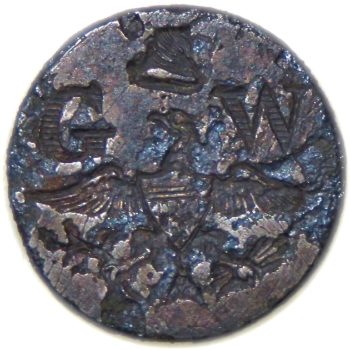
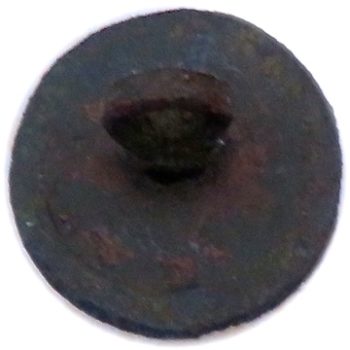
GWI 23-B THE “GW” MONOGRAM WITH EAGLE AND LIBERTY CAP
Color: An Awesome Sandy Brown Color.
Metal: Flat, 1-Piece, Stamped Design, Silvered Copper.
Size: 15mm. Cuff Size.
Rarity: R-5 Rating.
Variety Type: Wide W, Gilt Brass
Present Condition: A Wonderful Dug Specimen, A Fair Planchet Condition Remains, A Good Impression Remains.
Obverse Button Analysis: I like this button. It has the magic and spirit that went into GW Buttons.
Reverse Button Analysis: This is a one-piece button with a loop shank. The shank is original, straight, and intact.
Library Records Has Limited Information WI 23 B-1:
History: Yes Recorded Sales Price: Yes
Current Button Owner and Location: ~ New York ~
The RJ. Silverstein’s Isabela Collection.
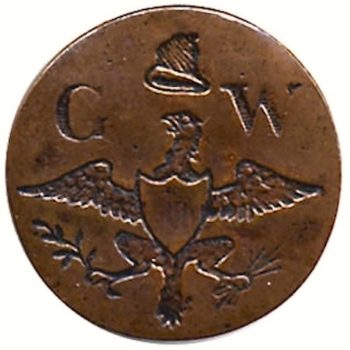
GWI 23-A THE “GW” MONOGRAM WITH EAGLE AND LIBERTY CAP
Color: A Lovely Hershey’s Milk Chocolate.
Metal: Flat, 1-Piece, Stamped Design, Gilt Brass.
Size: 25mm. Coat Size.
Rarity: R-5 Rating.
Variety Type: American Made / Narrow W,
Present Condition: A Non Dug Specimen, A Strong Planchet Condition, An Strong Impression Remains.
Obverse Button Analysis:
Reverse Button Analysis: This is a one-piece button with a loop shank. The shank is original, straight, and intact. For the strictest of accuracy, the previous seller noted a small, extremely shallow rim depression at the 3 o’clock position.
Library Records Has Limited Information WI 23 A-2:
History: Yes Recorded Sales Price: Yes
Current Button Owner and Location: No


GWI 23-B THE “GW” MONOGRAM WITH EAGLE AND LIBERTY CAP
Color: An Awesome Sandy Brown Color.
Metal: Flat, 1-Piece, Stamped Design, Silvered Copper.
Size: 15mm. Cuff Size.
Rarity: R-5 Rating.
Variety Type: Wide W, Gilt Brass
Present Condition: A Wonderful Dug Specimen, A Fair Planchet Condition Remains, A Good Impression Remains.
Obverse Button Analysis: I like this button. It has the magic and spirit that went into GW Buttons.
Reverse Button Analysis: This is a one-piece button with a loop shank. The shank is original, straight, and intact.
Library Records Has Limited Information WI 23 B-2:
History: Yes Recorded Sales Price: Digger Owner
Current Button Owner and Location: ~ South Carolina ~
Dug by James Jerdon in February 2018
The James Jerdon Collection.~
Dale believes it to be a plow field find.
What a wonderful find. Hats off to the man for metal detecting for years, it just paid off with the King of treasures! I Grant it Authenticity as True King 25 & 52 only can.
GWI 23-A THE “GW” MONOGRAM WITH EAGLE AND LIBERTY CAP
Color: A Nice Stone Brown.
Metal: Flat, 1-Piece, Stamped Design, Gilt Brass.
Size: 25mm. Coat Size.
Rarity: R-5 Rating.
Variety Type: Narrow W,
Present Condition: A Non Dug Specimen, A Strong Planchet Condition, An Exceptional Impression Remains.
Obverse Button Analysis:
Reverse Button Analysis: This is a one-piece button with a loop shank. The replacement shank is straight, and intact. The surface shows some mild pitting and pores’
Library Records Has Limited Information WI 23 A-3:
History: Yes Recorded Sales Price: Yes
Current Button Owner and Location: No
GWI 23-B THE “GW” MONOGRAM WITH EAGLE AND LIBERTY CAP
Color: A Sweet Silver.
Metal: Flat, 1-Piece, Stamped Design, Silvered Copper.
Size: 14.7mm. Cuff Size.
Rarity: R-5 Rating.
Variety Type: Wide W, Silver Plated.
Present Condition: A Dug Specimen, A Strong Planchet Condition, An Exceptional Impression Remains.
Obverse Button Analysis: This button is in excellent shape for being excavated. One of the best known specimens.
Reverse Button Analysis: This is a one-piece button with a loop shank. The shank is original, straight, and intact.
Library Records Has Limited Information WI 23 B-3:
History: Yes Recorded Sales Price: Yes
Current Button Owner and Location: ~ Virginia ~
Dug by Jimmy H. in Plymouth, North Carolina.~
The Bill Henderson Collection.~
GWI 23-B THE “GW” MONOGRAM WITH EAGLE AND LIBERTY CAP
Color: An Aged Silver Patina With Coppery-Brown Undertones.
Metal: Flat, 1-Piece, Stamped Design, Silvered Copper.
Size: 14mm. Cuff Size.
Rarity: R-5 Rating.
Variety Type: English Made / Wide W, Silver Plated.
Present Condition: A Dug Specimen, A Strong Planchet Condition, An Exceptional ImpressionRemains.
Obverse Button Analysis: A very rare example that was excavated in South Carolina.
Reverse Button Analysis: This is a one-piece button with a loop shank. The shank is original, straight, and intact. The reverse is surface flat and smooth with a few tiny scratches, and the planchet does appear to have remnants of the back stamp, “P & D Plated”.
Library Records Has Limited Information WI 23 B-4:
History: Yes Recorded Sales Price: Yes
Current Button Owner and Location: ~ South Carolina ~
Another Specimen Dug in South Carolina.
GWI 23-B THE “GW” MONOGRAM WITH EAGLE AND LIBERTY CAP
Color: An Aged Silver Patina With Coppery-Brown Undertones.
Metal: Flat, 1-Piece, Stamped Design, Silvered Copper.
Size: 15mm. Cuff Size.
Rarity: R-5 Rating.
Variety Type: English Made / Wide W, Silver Plated.
Present Condition: A Dug Specimen, A Strong Planchet Condition, An Exceptional ImpressionRemains.
Obverse Button Analysis: A very rare example that was excavated in South Carolina.
Reverse Button Analysis: This is a one-piece button with a loop shank. The shank is original, straight, and intact. The reverse is surface flat and smooth with a few tiny scratches, and the planchet does appear to have remnants of the back stamp, “P & D plated”.
Library Records Has Limited Information WI 23 B-5:
History: Yes Recorded Sales Price: Yes
Current Button Owner and Location: No
GWI 23-A THE “GW” MONOGRAM WITH EAGLE AND LIBERTY CAP
Color: A Nicely Aged Greenish Grey Hue with Golden Gilt Remnants.
Metal: Flat, 1-Piece, Stamped Design, Gilt Brass.
Size: 25mm. Coat Size.
Rarity: R-5 Rating.
Variety Type: Narrow W, Gilt Finish.
Present Condition: A Dug Specimen, A Strong Planchet Condition, An Exceptional Impression Remains.
Obverse Button Analysis:
Reverse Button Analysis: This is a one-piece button with a loop shank. The shank is original, straight, and intact.
Library Records Has Limited Information WI 23 A-4:
History: Yes Recorded Sales Price: Yes
Current Button Owner and Location: No
GWI 23-B THE “GW” MONOGRAM WITH EAGLE AND LIBERTY CAP
Color: An Aged Silver Patina With Coppery-Brown Undertones.
Metal: Flat, 1-Piece, Stamped Design, Silvered Copper.
Size: 14.7mm. Cuff Size.
Rarity: R-5 Rating.
Variety Type: English Made / Wide W, Silver Plated.
Present Condition: A Dug Specimen, A Strong Planchet Condition, An Exceptional ImpressionRemains.
Obverse Button Analysis: A very rare example that was excavated in South Carolina.
Reverse Button Analysis: This is a one-piece button with a loop shank. The shank is original, straight, and intact. The reverse is surface flat and smooth with a few tiny scratches, and the planchet does appear to have remnants of the back stamp, “plated”.
Library Records Has Limited Information WI 23 B-4:
History: Yes Recorded Sales Price: Yes
Current Button Owner and Location: ~ Virginia ~
Dug in Darion, South Carolina.~
The Henderson Collection.~
GWI 23-B THE “GW” MONOGRAM WITH EAGLE AND LIBERTY CAP
Color: An Aged Silver Patina With Coppery-Brown Undertones.
Metal: Flat, 1-Piece, Stamped Design, Silvered Copper.
Size: 15mm. Cuff Size.
Rarity: R-5 Rating.
Variety Type: English Made / Wide W, Silver Plated.
Present Condition: A Dug Specimen, A Good Planchet Condition, A Good ImpressionRemains.
Obverse Button Analysis:
Reverse Button Analysis: This is a one-piece button with a loop shank. The shank is original, straight, and intact. The reverse is surface flat and smooth with a few tiny scratches, and the planchet does appear to have remnants of the back stamp, “plated”.
Library Records Has Limited Information WI 23 B-6:
History: Yes Recorded Sales Price: Yes
Current Button Owner and Location: ~ South Carolina ~
Another Specimen Dug in South Carolina.
GWI 23-B THE “GW” MONOGRAM WITH EAGLE AND LIBERTY CAP
Color: A Silvery Brown.
Metal: Flat, 1-Piece, Stamped Design, Silvered Copper.
Size: 14mm.
Rarity: R-5 Rating.
Variety Type: English Made / Wide W, Silver Plated.
Present Condition: A Dug Specimen, A Strong Planchet Condition, An Exceptional Impression Remains.
Present Condition: A Dug Specimen, A Strong Planchet Condition, An Exceptional Impression Remains.
Obverse Button Analysis: This rare GW was excavated on a plantation in South Carolina by Ronnie M. Hyer using a New XP Deus Metal detector.
Reverse Button Analysis: This is a one-piece button with a loop shank. The shank is original, straight, and intact. The shank is unfortunately broken off. The surface is coarse, and shows green encrustations and micro porosity though out. The back stamp still shows some remnants of the original raised lettering within the channels. The Word “P & D Plated” is mostly worn down into the surface.
Library Records Has Limited Information WI 23 B-7:
History: Yes Recorded Sales Price: Yes
Current Button Owner and Location: ~ Alabama ~
Dug on an old plantation in South Carolina 2012.~
The Ronnie Hyer Collection.


GWI 23-B THE “GW” MONOGRAM WITH EAGLE AND LIBERTY CAP
Color: A Leather Brown.
Metal: Flat, 1-Piece, Stamped Design, Gilt Brass.
Size: 15mm.
Rarity: R-5 Rating.
Variety Type: English Made / Wide W, Gilt Finish.
Present Condition: A Dug Specimen, A Strong Planchet Condition, A Strong Impression Remains.
Obverse Button Analysis:
Reverse Button Analysis: This is a one-piece button with a loop shank. The shank is missing.
Library Records Has Limited Information WI 23 B-8:
History: Yes Recorded Sales Price: Yes
Current Button Owner and Location: ~ No ~
GWI 23-B THE “GW” MONOGRAM WITH EAGLE AND LIBERTY CAP
Color: A Golden Brown With Green Oxidized Stains.
Metal: Flat, 1-Piece, Stamped Design, Gilt Brass.
Size: 14.5mm.
Rarity: R-6 Rating.
Variety Type: English Made Wide W Gilt Finish.
Present Condition: A Dug Specimen, A Good Planchet Condition, A Strong Impression Remains.
Obverse Button Analysis: This button cleaned up real nice. The brass is still solid, but unfortunately has some metal deterioration to the surface. The obverse shows corrosion and porosity throughout the surface. The Eagle still retains a nice deep strike impression, and has a clear image of the head, neck, and wing feathers. The inner feather details of the wings, neck and tail are exhibited nicely. There is a strong impression for the federal shield, and the inner horizontal lines of the top half and vertical stripes in the lower half are still all accounted for. The Olive Branch still has a nice impression, and the petals outlines clearly show. The Bundle of Arrows also has a strong strike impression, and show a strong image of the tips, shafts, and nock feathers. The “GW” Monogram has a clear image, and shows all the inner definition lines clearly. The Liberty Cap has a nice strong strike outline and impression, and the inner definition lines still have an image. Overall, this button cleaned up nice and a real treasure find.
Reverse Button Analysis: This is a one-piece button with a loop shank. The shank is broken off. P.D PLATED rmdc
Library Records Has Limited Information GWI 23 B-9:
History: Yes Recorded Sales Price: Digger Owner
Current Button Owner and Location: ~ South Carolina ~
Dave Dug this in Hampton County South Carolina on 12-05-12
The D. Suiter Collection.
“I forgot to tell you about the story of the other WI-23b you have on your site found by Ronnie Hyer. That son of a gun was here visiting me and was my house guest when he dug that We were at a site one of my buddies has been hunting for years that he said coughed up over a thousand flat buttons. It wasn’t until we got in there with some new technology that the good buttons started showing up though. I got two perfect South Carolina Continental Army “dog bone” 1’s (Alberts GI 19) and another guy got one too. Another guy with us got the same but a 4th regiment and a possible SC dragoons. The guy that got us permission to the site dug a 60th loyalist, and Ronnie had 2 other one of a kind buttons, a pewter with 1C on it and another with a king George ish looking guy with a P on one side and a W on the other. I think I dug 4 Spanish silver coins and several king George coppers too not to mention 30+ flat/fancy buttons. We’re waiting for it to get turned over so we can hit it again, it’s an awesome site. Ronnie’s in Figi right now but we let him know the rarity of his button went down a notch with the addition of mine.
Mine and his were found about 8-10 miles apart and the other one I know of from the area was maybe 3 miles from where I dug mine. As close as they were all found though I think each one is from a different county. One other thing, one of the guys that was digging with us the day I dug my WI-23b said he told his brother about it and his brother told him he dug one of the same buttons there years ago but in the larger size. I’ll try to get him to get me a picture of it and forward it on to you.” -Dave
GWI 23-B THE “GW” MONOGRAM WITH EAGLE AND LIBERTY CAP
Color: An Aged Silver Patina With Coppery-Brown Undertones.
Metal: Flat, 1-Piece, Stamped Design, Silvered Copper.
Size: 15mm. Cuff Size.
Rarity: R-6 Rating.
Variety Type: English Made / Wide W, Silver Plating.
Present Condition: A Dug Specimen, A Good Planchet Condition, A Good ImpressionRemains.
Obverse Button Analysis:
Reverse Button Analysis: This is a one-piece button with a loop shank. The shank is original, straight, and intact. The reverse is surface flat and smooth with a few tiny scratches, and the planchet does appear to have remnants of the back stamp, “plated”.
Library Records Has Limited Information WI 23 B-10:
History: Yes Recorded Sales Price: Yes
Current Button Owner and Location: ~ South Carolina ~
Another Specimen Dug in South Carolina.
GWI 23-A THE “GW” MONOGRAM WITH EAGLE AND LIBERTY CAP
Color: A Charcoal Brown With Greenish/White.
Metal: Flat, 1-Piece, Stamped Design, Gilt Brass.
Size: 25mm.
Rarity: R-5 Rating.
Variety Type: English Made / Wide W,
Present Condition: A Dug Specimen, A Good Planchet Condition, A Strong Impression Remains.
Obverse Button Analysis: This is another great example of this rarely seen button.
Reverse Button Analysis: This is a one-piece button with a loop shank. The shank is original, straight, and intact. The surface shows some mild pitting and porousness. The raised E & D Gilt mark within the depressed channel still has an outline.
Library Records Has Limited Information WI 23 A-5:
History: Yes Recorded Sales Price: Dug By Owner
Current Button Owner and Location: ~ North Carolina ~
Excavated in Washington County North Carolina in 1980 by Jimmy Hardison.~
The J. Hardison Collection.
Isabela’s Notes: Jimmy Hardison has been a digger since 1966, and he has personally dug “3” GWI 23-A’s. He has quite a bit of knowledge about old home sites, and has personally dug several kinds of GW buttons. In one phone conversation, he mentioned that his friend dug 2 more that are “not exampled above.” Totaling 5 found on this old home site that vanished after 1840. His third was sold to Bill Henderson of the Picket Post which is exampled above.~
Isabela’s Notes: At the bottom of the page is a letter written by A. Albert referencing to a back mark of GWI 23-A. He mentions that his collector associates believes that the GWI 23-A with the Back mark “E & D Gilt or Plated: is a re-issue commemorative made in 1799 for Washington’s death. After researching Albert’s hypothesis, I have come to a different conclusion from Albert’s collector associates. The “E & D Gilt or Plated back mark that is in raised letters within a depressed channel was made in the 1790’s during Washington’s Administration. Being that George Washington was in office from April 30th, 1789 to March 4, 1797, and knowing that inaugural buttons were made during much of this whole time period; I believe that this was either a later made rendition 1801 of the original 1st issue without a back mark, or just another (different) Artisan/Craftsman’s version that was done at a latter time period of his Presidency. The raised E & D back mark within the depressed channel was known to come out in the 1790’s, and this back mark is just one of the earliest known buttons to be produced with it. So in my opinion, this would be a George Washington Inaugural Button, and not a later commemorative re-issue for his death in 1799 as Albert’s collector associates hypothesize.
